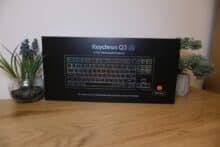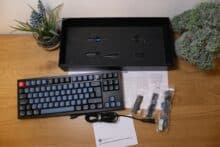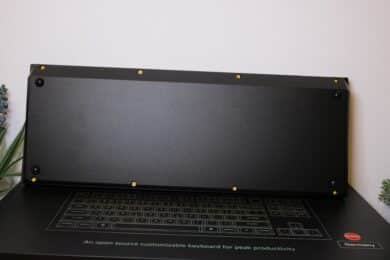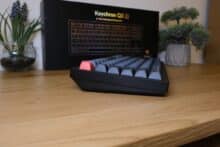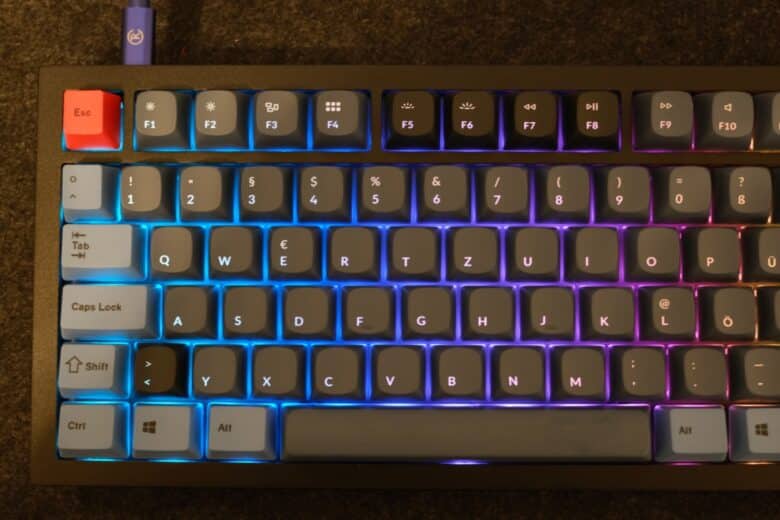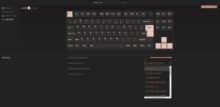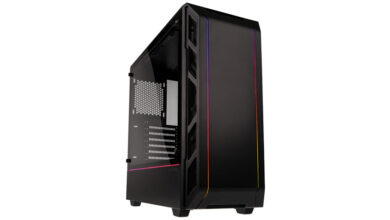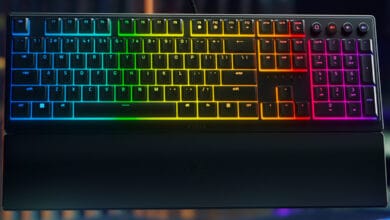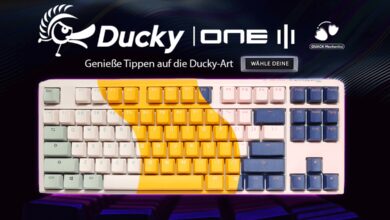
Manufacturer Keychron from China is one of the best-known names in the field of high-quality mechanical keyboards. After all, OnePlus has now also teamed up with the experts for its first own keyboard. Besides the V and K model series, the manufacturer also offers different variants of the Q series with a German ISO layout. We took a closer look at these in the form of the TKL keyboard. What we liked and where there is reason for criticism is clarified in our Keychron Q3 test.
Technical Specifications
| Button switch type | Mechanical |
| Switch types | Gateron G Pro Red; Brown; Blue |
| Switch interchangeable | yes (hot swap) |
| Material | Aluminum |
| Dimensions (W x H x D) | 365.1 mm x 32.9 mm x 137 mm |
| Weight | 1,997 grams |
| Cable connection | USB Type-C |
| Rollover technology | N-Key Rollover |
| Key Caps | ABS plastic |
| Operating Modes | Typing; Gaming |
| Features | Replaceable keycaps and switches; Quiet dampening; Keycaps and tools included; Windows and Mac modes; Clickable knob |
| Colors | Black/Blue/Red |
| Price | € 229.90 * |
Keychron Q3 review: the scope of delivery is unbeatable
- Gigantic scope of delivery with lots of accessories
- macOS and Windows keycaps included
- Additional gaskets, stands and more
Before we get to the actual keyboard in the Keychron Q3 review, we want to praise the included accessories. Sure: The Q3 is anything but a bargain with a price of around 230 Euros. However, the customizable mechanical keyboard is not overpriced compared to its competitors, such as the recently reviewed Ducky One 3, which is in a similar price range.
Keychron already skilfully plays up strongly in the scope of delivery. Compared to many other mechanical keyboards from the manufacturer, the large and comparatively heavy box comes with a whole lot of accessories.
Of course, there is the keyboard itself. And the obligatory manual (unfortunately only in English), as well as the 1.8 meter long, fabric-covered USB-C to USB-C cable including USB-A adapter are also included.
However, the scope of delivery does not end there. Like all keyboards from the manufacturer, the Q3 is designed for both Windows and macOS. The keyboard is equipped with a macOS key layout ex-works, so you will also find the matching Windows keycaps (i.e. the Windows key, Alt and Alt Gr twice) in the scope of delivery.
In addition, there are a total of 13 further keycaps, which are primarily intended for the number row and come up with three third alternative lettering. Which, as you know, you activate via the CTRL+Alt key combination under Windows. So the square brackets at the keys 8 and 9 and so on.
Then you’ll find a whole bunch of other accessories in the box. Among them are stabilizers, sound-absorbing foam, six additional seals (“gaskets”) and of course all the tools like a keycap and switch puller to replace the keycaps and mechanical switches. Keychron even includes a small Phillips screwdriver and an Allen wrench.
I have never seen a mechanical keyboard with such a lavish scope of delivery. A palm rest is unfortunately not included, but I didn’t really miss it during the test.
Design and workmanship of the Keychron Q3
- Extremely high-quality workmanship
- Rugged design; heavy weight
- Only ABS keycaps; position of the “knob” suboptimal
The first thing you notice when taking the Keychron Q3 out of the box is the enormous weight of the keyboard. The keyboard weighs a whopping 1,997 grams – that’s almost twice as much as the full-size Ducky One 3.
The Q3 is made entirely of 6063 aluminum – a material that is normally used in architecture and construction, as well as in the medical and automotive industries. The metal body of the keyboard is also CNC-milled, polished, anodized and sandblasted, which the manufacturer claims to have created a “solid piece of metal art”.
Whether or not the mechanical keyboard is a work of art is up to each person to decide. However, the Keychron Q3 feels extremely robust and high-quality. The anodized surface also leaves no chance for fingerprints and scores with a high-quality build and a chic look.
However, with all the high-quality and luxurious materials, it is surprising that the manufacturer saved on the keycaps. Unfortunately, high-quality and durable double-shot PBT keycaps are not installed. Instead, blue and black keycaps made of cheap ABS plastic find their place on the board.

They are, for ABS standard, of good quality and offer a pleasant pressure point, but they are very susceptible to fingerprints and probably won’t last too long. In the long run, it is advisable to spend a few more Euros and invest in robust PBT keycaps.
But back to the design. The Q3 is 365.1 mm wide, 32.6 mm (back) and 19.7 mm (front) high and 137 mm deep. A look at the bottom reveals that the keyboard does not have adjustable feet. Thus, you have to live with the angle that the manufacturer deems correct. That’s a shame, although I find the angle comfortable after a bit of getting used to it.
On the back of the keyboard, you will find the USB-C port in the upper left corner, where the necessary cable has to be attached. Next to it is the switch that allows you to switch between Windows and Mac functionality.
On the bottom, the manufacturer has placed four rubberized feet in the corners, which are not particularly large, but still hold the keyboard securely in place. A total of eight gold-plated Torx screws can be used to access the keyboard’s interior.
Another special feature marks the so-called “Knob”. This is a robust knob made of metal, which has a pleasant feel thanks to its ribbed pattern. It is not only rotatable, but also clickable. By default, you can use it to adjust the volume or mute the system immediately, but it is programmable (more on that later).
The only shortcoming of the otherwise very practical knob is, in my eyes, its position. Why this sits between the F12 and screenshot buttons and not somewhere on the edge is beyond me.
RGB lighting, settings and modding
- Fancy RGB lighting
- Many effects to choose from
Of course, the Keychron Q3 can’t be without customizable RGB lighting. By default, FN key combinations can be used to switch between quite a few effects, increase or decrease the brightness of the lighting, increase or decrease the speed of the effects, or completely disable the lighting.
From static colors to wave effects to reactive effects, everything you could want is offered here. According to the manufacturer, an Arm Cortex-M4 32-bit STM32L432 processor is used inside, which is supposed to work particularly power-saving. It is difficult to say whether this is true and how much power it saves. However, it doesn’t really matter since the keyboard can’t be used wirelessly anyway.
I would describe the quality of the RGB lighting as good to very good. With the standard keycaps, the light shines evenly through the lettering on the keys, but mainly extends to the areas around the keys.
Supporting software: VIA / QMK
- Open source companion software with many options
- Settings on demand directly in the browser
- Adjustment of the rotary control cumbersome
As an open-source keyboard, the manufacturer does not offer its own companion software for the Q3. However, this is circumvented by the compatibility with the QMK and VIA solutions. The latter can be used directly via the vendor’s homepage or downloaded from the Keychron website.
The software significantly expands the capabilities of the mechanical keyboard. A whole four layers of assignments can be saved and recalled. Each key can be reassigned individually. In addition, macros can be created and the lighting effects can be adjusted in terms of brightness, color effect and effect speed.
Regarding the key assignment, you have the choice between different functions, which are divided into categories in the menu on the left. The remapping of the keys is self-explanatory: Just click on the key you want to remap, select the desired function and you’re done.
For the knob the matter is a bit more difficult. Here, the JSON file must first be downloaded from the Keychron homepage and imported into the software so that the knob is displayed as three buttons – these can also be freely configured afterwards.
For example, the respective voice assistant can be called up by pressing it, or the rotate function can be used to zoom in or out of the picture.
Modding options of the Keychron Q3
Besides the Glorious GMMK Pro, Keychron keyboards are, of course, primarily known for their strong moddability. The manufacturer takes this to the extreme with the Q model series. It starts, quite unspectacularly, with the possibility to exchange the keycaps and mechanical switches (the latter via hot swap). Of course, this is already known from many other high-quality mechanical keyboards.
Keychron installs Gateron G Pro switches ex-works, which are supposed to wobble less compared to other switches. Depending on the model, the manufacturer equips the Q3 with either red (linear), brown (tactile) or blue (clicky) switches.
However, the keyboard is compatible with almost all MX-style mechanical switches with 3 and 5 pins. No matter if they come from Gateron, Cherry, Kailh or other manufacturers. So you can – with a few exceptions – use almost all mechanical switches that the market has to offer.
As already mentioned, the Q3 can also be screwed on at the bottom and modified even further. There are two damping layers on the bottom cover, followed by the PCB and another noise-dampening layer, before the top cover, switches and keycaps follow.
The switches are also pre-lubricated, while the stabilizers – which are used for longer keys like the space bar, backspace and co. – are simply screwed on and can thus be replaced or optimized. Between each layer, you can add dampeners or make modifications.
I’m really not a professional in this field, but the possibilities are almost unlimited. So you can directly influence the noise, typing feel, and stability. Not that the Keychron Q3 needs this, because the mechanical keyboard already shines in the mentioned categories ex works.

Professionals, however, should be happy about that. Only the ping noise during typing is a bit high by default, which might disturb one or the other. You can easily remedy this with a simple tape mod.
By the way: If you want, you can also order the Q3 as a barebone version and thus equip it with already existing switches and keycaps or buy them separately.
Practical and desk test
- Excellent switches
- Great cushioning and stabilizers
- (For me) Very pleasant typing noise
In the field test of the Keychron Q3, I was absolutely thrilled with the mechanical keyboard, admittedly after a bit of getting used to it due to the lack of angle-adjustable feet. The built-in Gateron G Pro Brown switches score with a pleasant release force of 55 gf, but offer the same release point as linear red switches.
The result is a pleasantly tactile but fast typing feel that is equally convincing for gaming and typing. The stabilizers of the larger keys are also convincing in my eyes. The manufacturer definitely did not promise too much here.
Sure, there’s still some fine-tuning that can be done here, but when I compare the whole thing to other keyboards in the same price range – like the Mountain Everest or the Ducky One 3, the Stabis do a really great job here.
With the ability to customize key assignments and create markos on the software side, the Q3 is clearly ahead of the Ducky model. Compared to dedicated gaming keyboards, the customization via the respective accompanying software works a bit faster than via the open source software in this case.
However, these are merely nuances, because once set, even fast competitive shooters or longer macros go off smoothly and reliably at the touch of a button.
The acoustics of a mechanical keyboard are, of course, always divided. Some prefer a quieter sound, others a louder, muffled tone. The Q3 is more in the high-frequency range, but still triggers pleasantly and comparatively quietly, as our sound test of various keyboards proves. The sound reminds me a bit of a good old typewriter.
Keychron Q3 (Gateron G Pro Brown)
Ducky One 3 (MX Silent Red)
Mountain Everest (Cherry MX Brown)
Keychron Q3 review: conclusion
If you spend over 200 euros on a keyboard, you can also expect a lot. In my eyes, Keychron delivers here with the Q3 across the board. This already starts with the scope of delivery, which easily puts all keyboards I’ve held in my hands so far into the bag.
You can tell from the very first second that the Keychron Q3 is really a premium device. From the robust construction to the chic, anodized finish to the first-class stabilizers and the pleasant typing noise and feel, almost everything is right here.
However, why only cheap ABS keycaps were used – which are of good quality, but can’t hold a candle to PBT keycaps by far – remains a mystery to me. Just like the positioning of the rotary knob, which is extremely practical, but also a bit difficult to reach above the backspace key.
With a feature set of (once again) more expensive mechanical keyboards and the excellent modifiability, the Keychron Q3 scores many plus points on the credit side and marks an excellent entry point into the world of custom keyboards.
So is the Q3 the perfect keyboard? No, it isn’t. I also dare to doubt that there is THE one perfect keyboard for everyone. But here you get for the price just significantly more offered than with the comparably more expensive competition.
Keychron Q3
Workmanship
Features
Ergonomics
Software
Value for money
95/100
The Keychron Q3 absolutely lives up to its premium price and scores with an excellent configuration, huge scope of delivery and strong technology. An excellent mechanical keyboard with minimal points of criticism that you can largely eliminate yourself.



